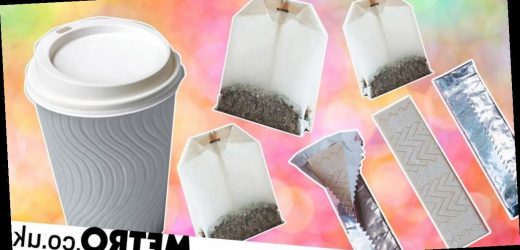If you’re making a conscious effort to be more environmentally friendly, you’re probably trying to be careful about how much plastic you use.
Ok, you’ve ditched the cling-film in favour of reusable containers, you use soap bars now instead of bottles of shower gel. But what about hidden plastics?
There is plastic lurking in tonnes of everyday products – and most of us don’t even realise it’s there.
The good news is that there are environmentally friendly versions of most of these products, but you can’t make a change unless you know where to find these sneaky bits of plastic.
Yogesh Bali, managing director at Nothing Wasted, has outlined some of the everyday products that can contain hidden plastics – to help you make smarter and greener choices.
Foods
‘Micro plastics are either deliberately placed in some of our foods or, due to plastic pollution, are starting to seep into our very natural food supply,’ Yogesh tells Metro.co.uk.
‘Italian university researchers have found microplastics in everyday essentials such a lettuce, broccoli and potatoes with the highest levels found in apples and carrots.’
Below are some items that Yogesh says we all use without realising the hidden plastic content:
Teabags
‘Most teabags contain plastic to keep the tea in the bag, keep the bag’s shape and keep them heat resistant,’ he explains. Yogesh adds that In the UK, we make over 160 million cups of tea every day – that is a lot of plastic.
‘There are some degradable brands out there now which use PLA (a commercial compostable type of plastic). However, these present their own challenges and the box they come in usually has plastic inside or out.
‘There are tea infusers in the market now where you can use loose leaf tea so you can make your own wonderful concoctions.’
Chewing gum
‘Chewing gum has been around for thousands of years, the only difference is, we’ve made it super durable, super strong and super hard to get rid of,’ says Yogesh.
He explains that most gum bases contain plastic with a leading ingredient being polyisobutylene – which is the same material tyres are made out of.
‘The other material used is polyvinyl which is also used in glue and rubber. Now we know why we’re told not to swallow chewing gum.’
Sea salt
Yogesh says sea salt is a clear example of plastic pollution on an everyday item almost all of us use.
‘Studies have found that 90% of table salt contains micro plastics,’ he says.
‘This is due to the levels of plastic in the sea where salt is derived. An average of 2,000 micro plastic particles are consumed per person, per year through salt.
‘Although this item is specific to salt, the hidden plastic in sea water impacts all sea born products.’
Non-foods
‘Plastic is woven into our everyday lives in such a way that we can not easily distinguish it from more natural materials we use,’ says Yogesh.
Clothing
‘The clothes we wear contain plastic,’ says Yogesh. ‘That’s right, the trendy jeans and top you’re wearing, or the lovely dress, probably has plastic in it.
‘Every time we wash our cloths they shed a little bit of plastic which passes through water treatment centres into our rivers and oceans.
‘These are in turn ingested by fish and make their way through the food chain onto our plate.
‘There are alternatives out there, check the labels for natural materials like cotton, bamboo or hemp.’
Wet wipes
We have all used disposable wet wipes for cleaning up spills, removing make-up or changing nappies. But these wipes are made to be durable using combined cotton with polyester (which is plastic).
‘Disposing of these means that each wipe will remain on the planet for hundreds of years,’ says Yogesh. ‘Another major problem with these is that people often flush them down the toilet.
‘These are not the same as toilet paper and flushing them down the toilet introduces them to the ocean and is a leading cause of drains and sewers becoming blocked.
‘Alternatives, such as a washcloth or biodegradable wipes, can provide a better environmental and economical alternative.’
Aluminium cans
You might think a can is better than a plastic bottle, but sadly aluminium cans also contain a thin layer of plastic. Yogesh says it’s there to prevent a chemical reaction which can cause corrosion.
‘Luckily though, all is not in vain,’ he says. ‘The way the thin layer is put together with the can means that luckily the cans are still recyclable so still a infinitely better option than buying a plastic bottle.’
Coffee cups
Most people know about this one – hence the boom in reusable coffee cups – but the UK’s coffee shops still produce an estimated 2.5 billion disposable cups.
‘The inside of these paper cups is lined with plastic to prevent leaks and provide structure to the cups, not to mention the lids,’ says Yogesh.
‘Many coffee shops now offer reusable coffee cups for purchase which is a great investment for the planet and potentially for your wallet as they offer discounts for using a reusable cup instead of a disposable one.’
Glitter
‘These shimmering, shiny little sparkles are basically fabulously dressed up microplastics,’ explains Yogesh.
‘They are made with sheets of aluminum infused plastic shredded down. If you’ve used glitter before you know how difficult it is to get rid of.
‘We dose our faces and the faces of our children in microplastics when we use glitter.
‘Glitter should never be flushed down the drain as it will always end up in the ecosystem.
‘There are new biodegradable options entering the market for those of you who want to add the mini sparkles to your day.’
Foil packets
Most commonly used for crisps, this kind of packaging are made of a thin metal, but are also embedded with plastic.
‘This makes them extremely difficult to recycle,’ says Yogesh.
‘The largest manufacturer of crisps in the UK produces some 3.6 billion packets a year for which we do not have an established recycling program.’
Paper food and drink packaging
‘As with coffee cups, paper looking packaging often has a layer of plastic in them to prevent leaks and keep the structure of the packaging,’ says Yogesh.
‘These are used by food take away outlets and store based retailers – milk cartons, paper plates etc.
‘There are many biodegradable alternatives now available for commercial use, we just need a mindset change to use these instead of the plastic-based ones.’
Georgina Wilson-Powell is the founder of sustainable living magazine, pebble, she says it’s important to think about other swaps we can make as well.
‘In your bathroom, you can do a number of straight swaps to reduce hidden plastic,’ Georgina tells Metro.co.uk.
‘Stainless steel razors for disposable ones (which can’t be recycled), loofahs for plastic netted sponges, reusable makeup pads for disposable face wipes and refillable or wooden-cased makeup for mainstream plastic tubes and pots.
‘The beauty industry produces 120 billion items of packaging a year. Swap to one of the huge number of natural beauty and skincare brands offering products in glass or without packaging at all.’
She also says we need to think about where we are ordering from when we do our online shopping.
‘The fast growing amount of deliveries we’re all getting, as we order everything from clothes to gin online, contain a worryingly large amount of plastics – from tiny ties to bubble wrap,’ she says.
‘Smaller, sustainable brands are much better at avoiding plastic packaging and will highlight it often online so look for companies making that commitment.’
Do you have any environmental tips to share? We want to hear from you.
Get in touch: [email protected].
Source: Read Full Article




